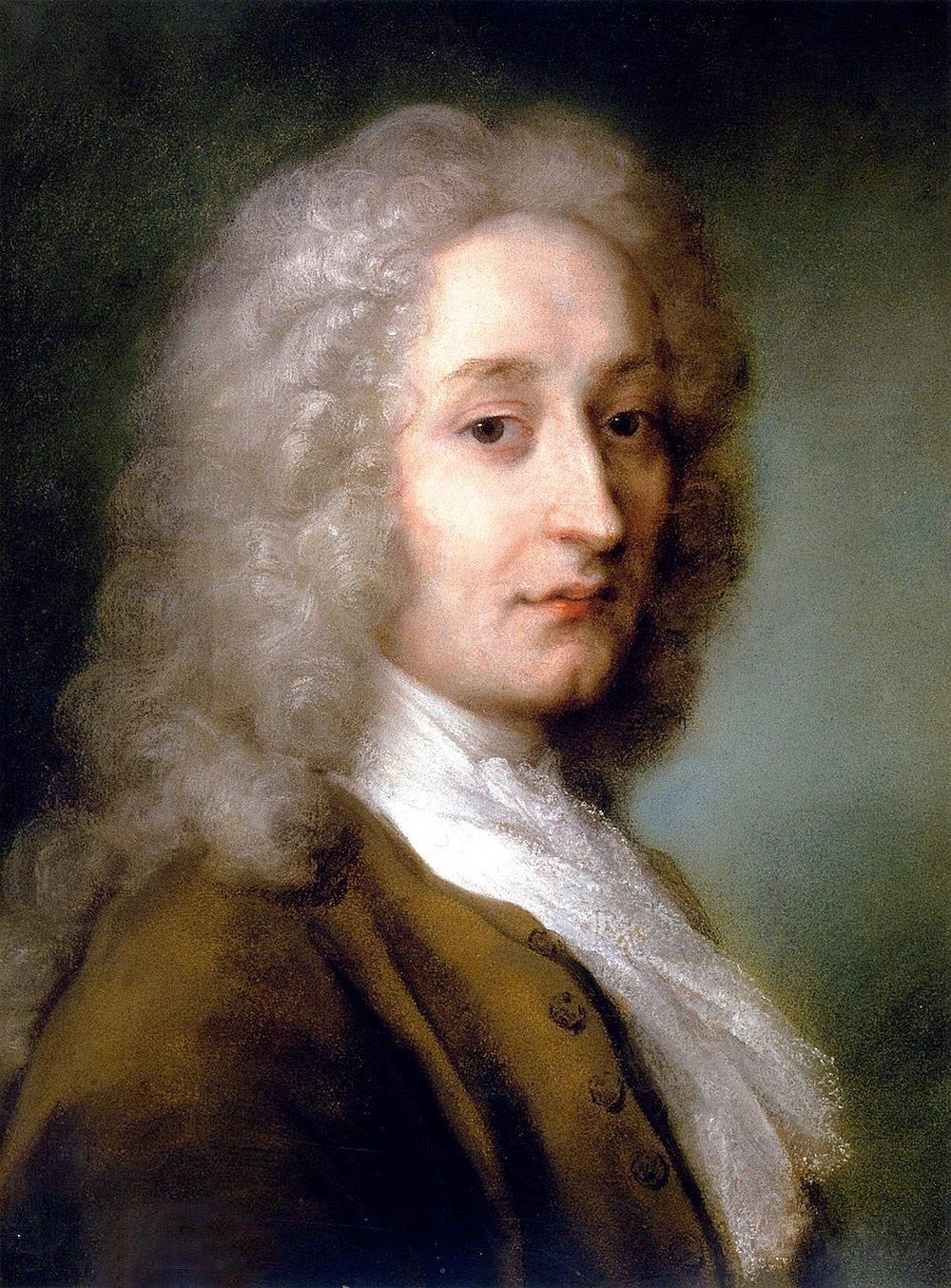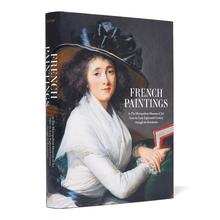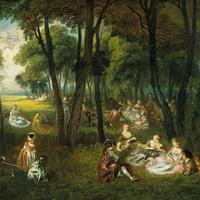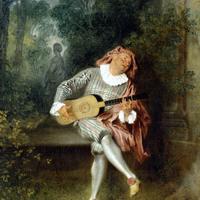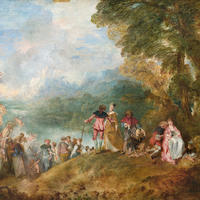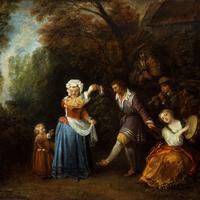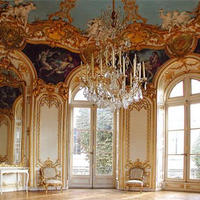More about Jean-Antoine Watteau
- All
- Info
- Shop
Works by Jean-Antoine Watteau
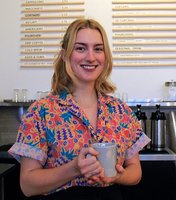
Contributor
Jean-Antoine Watteau was one of the forerunners of Rococo, arguably the art movement that is most fun to say.
This was the tail end of Baroque, and Watteau paved the way for some real sexy numbers like the famous swingers, which was painted about 40 years later.
Watteau was one of the painters who represented a more casual turn in art. After the chill and poised Renaissance, the baroque style was concerned with beautifully executed but super dramatic and often gory historical and religious subject matter. Now, artists, buyers, and royalty wanted to celebrate fun things like idyllic pastoral scenes, the loveliness of flesh (gross), and true love (grosser). This was the beginning of the hedonist art movement, and we all will just have to wish we could have been there. Watteau’s subject of choice was the “gay wanton party”. Perhaps this was to cheer him up during his many bouts of illness and sadboy-ness.
Most of the information about Watteau that scholars agree on comes from what friends wrote about him once he gained some fame in Paris. Although his family wasn’t poor, he was not from artistic roots. The son of a roofer, his father supported his artistic tendencies and set him up with a teacher from the limited supply in their hometown of Valenciennes. His first teacher was a lackluster painter, which all of Watteau’s biographers love to lightly mock. When he realized there was nothing more to be gleaned from this teacher, he moved with no money to Paris around 1702, initially to help build and paint sets with an Opera company. The costumes he would see inspired his later, very fashionable paintings.
Eventually Watteau worked for a dealer, painting copies of more famous paintings for the dealer to sell. Watteau was a favorite as he produced his work quickly and could work on any part of the painting, as opposed to some of his other colleagues. Understandably, this was not a path he wanted to take, and he found this work “disgusting." A lot of us freelancers feel that way, buddy! Even so, he grew very tired of this work which led him to draw constantly. This probably saved his pasty little butt from a life of nothingness: his commitment put him ahead of lots of other artists. .
He pretty much invented the “fete galante” which is the french way to say people dressed fancy being outside, and ended up influencing fashion trends for quite a while. Like any artist from this long ago, some of his life is a bit mysterious, and it doesn’t help that he died young, at only 37. Some contemporary accounts give us special insight about him, his precarious health, and his sadboy tendencies. For instance, we know he was pretty intense about his work, to the point of being a bit of a loner. It was said that he kept a lot of secrets and spent a lot of time alone, mostly with the aim of being left alone to work on his art. He was prone to moving around often, unable to find a living situation that fit his volatile personality and didn’t interrupt his focus. Although he could finish paintings quickly, he was a bit of a perfectionist, waiting 5 years to send the piece promised to the famous French Royal Academy upon his acceptance.
While living in Paris, Watteau received monetary success with dealers and was lauded by his contemporary artists. Unfortunately, he did not enjoy this for long. After a year long trip to England to see a doctor for his bad health he returned to Paris. His health quickly declined again, and in 1721, hoping to return to his hometown (perhaps knowing he was dying) he was only well enough to travel to Nogent, France. A couple months later, he died of tuberculosis. His love of painting was so great, it’s said that he was in a daze and painting imaginary paintings in the air in a state of feverish delusion. The art world was quite sad at his early death, and we all will mourn the nudie paintings that he ordered destroyed at his death.
Sources
- Baetjer, Katharine, and Cowart, Georgia. Watteau, Music, and Theater. New York: Metropolitan Museum of Art, 2009.
- Charles, Victoria, and Carl, Klaus. Rococo. New York: Parkstone International, 2012. Accessed February 20, 2019. ProQuest Ebook Central.
- Roland, Michel. Watteau, an Artist of the Eighteenth Century. New York: Alpine Fine Arts,1984.
- "Work: Pilgrimage to Cythera." Louvre Museum. Accessed February 28, 2019. https://www.louvre.fr/en/oeuvre-notices/pilgrimage-cythera.

Contributor
The father of Rococo, Jean Antoine-Watteau (better known as Antoine Watteau), was born to a roof tiler.
Nothing artistic of note came into his life until he moved to Paris on his eighteenth birthday, penniless but full of potential. He first apprenticed with an older artist, then moved on to creating work in a workshop specializing in votive paintings. By 1703 he would meet his mentor, Claude Gillot, who would help him lay down the contextual foundations for his work in the years to come.
Watteau’s signature work was mainly influenced by the Commedia dell’Arte (of which Gillot was a huge fan), the ornateness of the contemporary French interior design (which was inspired from his time working under Claude Audran III, an interior decorator), and opera ballet. This gave Watteau’s work a theatrical composition, with bright and vibrant color, yet a melancholy undertone that was resigned to life’s shortness. By using these themes in his work, he hoped to change the notion of comedies and theatre as “low art,” as it had been seen in earlier centuries.
He was encouraged to vie for the Prix de Rome, an art scholarship that would allow him to study in Rome, in 1709, but to no avail, winning only second place. Watteau tried again to better fortunes in 1709, impressing the Royal Academy of Painting and Sculpture so much they made him a full member. At that point, a trip to Rome was trivial. The piece that won him his admittance, Pilgrimage to Cythera, took five years to complete and was finally submitted in its final version in 1717. Even college students these days don’t get to procrastinate that far out!
The French painter was also a draftsman, where the bulk of his work comes from. He made very few painterly compositions. Watteau was known for his mastery of the “trois-crayons” technique, in which he layered red, black, and white chalk on top of each other to bring further dimensionality to his sketches. Seriously, he makes your local coffee shop’s chalkboard doodles look like a five-year old’s crudely drawn stick figure. He is best known for his bucolic scenes of courtiers enjoying themselves in the countryside, known as the Fête galante. Contrary to what his subject matter may suggest, however, his main patrons were never the landed gentry, but the new money bourgeoisie such as bankers and dealers.
Plagued by lousy health all his life, he traveled to London to seek medical assistance from a Dr. Richard Mead. A good step toward a longer life, except this is London we’re talking about. The humidity and pollution of the English capital rendered any nutritional or medicinal remedy moot. His last days were spent in the residence of his patron and it was there that he finally died to tuberculosis laryngitis at the age of thirty-six, on July 18th, 1721.
Sources
- "Biography of Jean-Antoine Watteau." Jean-Antoine Watteau - The Complete Works. 2002. Accessed February 28, 2019. http://www.jean-antoine-watteau.org/biography.html.
- Macchia, Giovanni. "Antoine Watteau." Encyclopædia Britannica. January 17, 2019. Accessed February 28, 2019. https://www.britannica.com/biography/Antoine-Watteau.
- Stein, Perrin. "Antoine Watteau." The Met's Heilbrunn Timeline of Art History. October 2003. Accessed February 28, 2019. https://www.metmuseum.org/toah/hd/watt/hd_watt.htm.
Featured Content
Here is what Wikipedia says about Antoine Watteau
Jean-Antoine Watteau (UK: /ˈwɒtoʊ/, US: /wɒˈtoʊ/,
French: [ʒɑ̃ ɑ̃twan vato]; baptised October 10, 1684 – died July 18, 1721) was a French painter and draughtsman whose brief career spurred the revival of interest in colour and movement, as seen in the tradition of Correggio and Rubens. He revitalized the waning Baroque style, shifting it to the less severe, more naturalistic, less formally classical, Rococo. Watteau is credited with inventing the genre of fêtes galantes, scenes of bucolic and idyllic charm, suffused with a theatrical air. Some of his best known subjects were drawn from the world of Italian comedy and ballet.
Check out the full Wikipedia article about Antoine Watteau

